What is a Farmhouse Nursery: A Comprehensive Guide

Introduction to what is a farmhouse nursery
In the world of interior design, there’s a timeless style that never fails to bring warmth, comfort and a sense of nostalgia – the farmhouse style.
But have you ever wondered about integrating this rustic charm into a nursery? That’s exactly where a farmhouse nursery comes into play. So, what is a farmhouse nursery? Let’s dive into this heartwarming topic.
What is a farmhouse nursery?
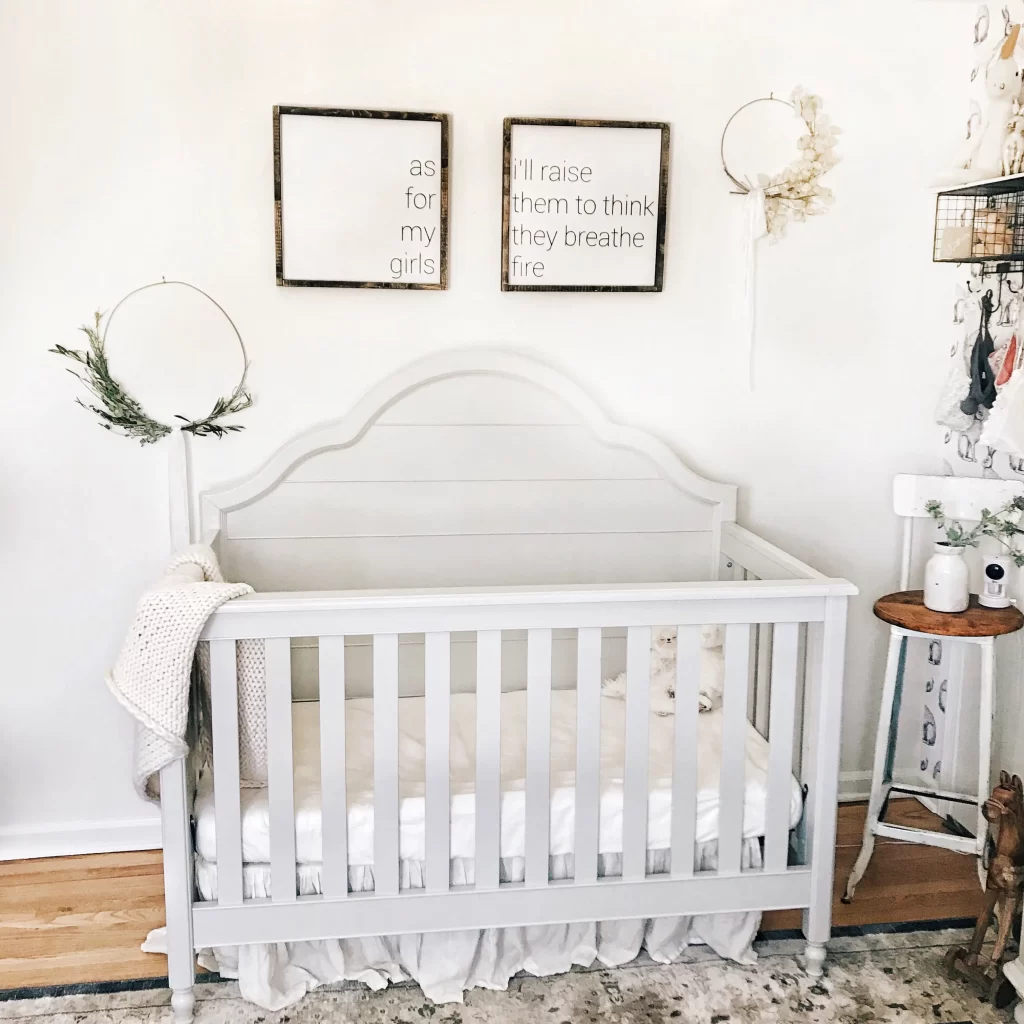
A farmhouse nursery is a comforting, rustic-inspired space designed for infants and toddlers. This style draws its inspiration from old farmhouses and country living, characterized by its use of vintage items, natural materials, and a neutral color palette.
Think distressed wood, galvanized metal, and warm, cozy textiles. Imagine bringing the tranquility of the countryside into your little one’s room. Isn’t that something to swoon over?
14 Homegrown farmhouse nursery ideas
The perfect farmhouse-style crib
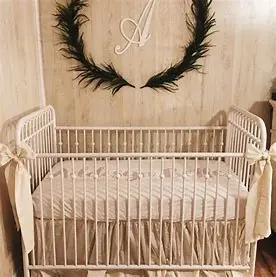
Look for a crib with a rustic finish, such as distressed wood. The crib is often the centerpiece of the nursery, so choosing a farmhouse-style crib sets the tone for the rest of the room.
Gaines-approved farmhouse nursery decor
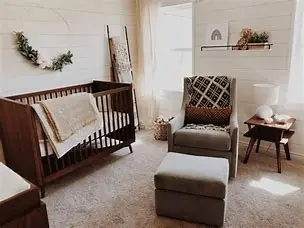
Take inspiration from Joanna Gaines and opt for decor that blends simplicity with sophistication. Think of soft textiles, wooden toys, and vintage prints.
Shape up & shiplap farmhouse nursery.
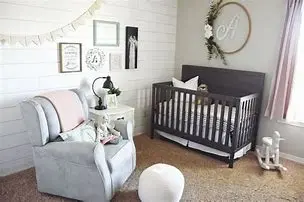
Shiplap walls are a staple in farmhouse design. They add texture and interest to the room and create a beautiful backdrop for other decor elements.
Charming farmhouse nursery details

Pay attention to the small details. A vintage rocking chair, a rustic lamp, or a collection of antique children’s books can add charm and character to the room.
Pop of pink farmhouse nursery

While farmhouse design typically involves a neutral color palette, don’t be afraid to add a pop of color. A soft pink, for example, can bring warmth and femininity to the room.
Farmhouse nursery barn doors

Consider installing barn doors for the closet. Not only are they functional, but they also add a distinct farmhouse touch to the room.
Deep gray farmhouse nursery
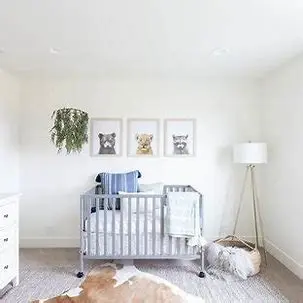
Consider a deep gray color scheme for a modern twist on the farmhouse nursery. This can create a sophisticated, gender-neutral space.
Incorporate antiques into your farmhouse nursery.
Antiques can add a sense of history and charm to the room. Look for items like vintage toys, old picture frames, or a classic rocking horse.
Green farmhouse nursery

Bring the outside in with touches of green. This could be through plants, a green accent wall, or green textiles.
Buffalo check farmhouse nursery.
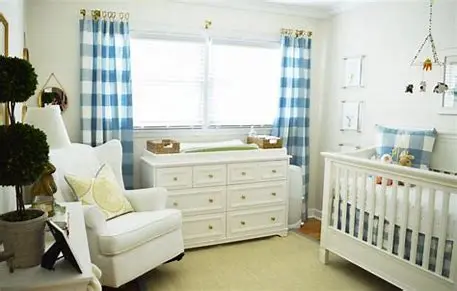
Buffalo check is a classic pattern that fits perfectly in a farmhouse nursery. You could incorporate it through bedding, curtains, or a rug.
Farmhouse nursery word art
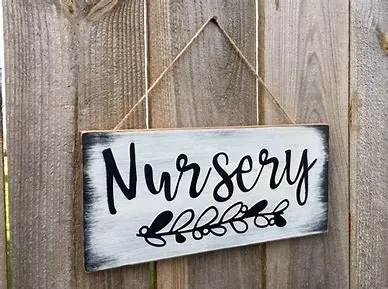
Decorate the walls with word art. This could be a favorite quote, your child’s name, or even a classic nursery rhyme.
Vintage farmhouse nursery
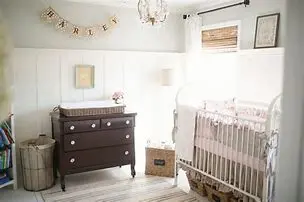
Embrace the vintage aesthetic with distressed furniture, antique decor, and heirloom pieces.
Soft-hued farmhouse nursery
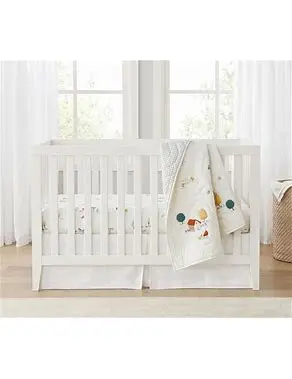
Opt for a soft, soothing color palette. Think cream, taupe, and soft blues and greens.
Farmhouse nursery wood toys & built-ins
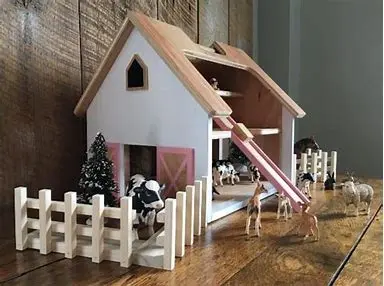
Wooden toys and built-in shelving units serve a practical purpose and contribute to the overall farmhouse aesthetic of the room.
Key elements of a farmhouse nursery style include:
Colors and Styles: Farmhouse spaces usually come in neutrals or warm and muted shades, though contrasting color schemes like black and white, graphite grey and white, or hunter green and white are also common. The ambiance can be softened with elements like wood, potted plants, and various textiles.
Furniture and Décor: Reclaimed wooden walls, brick elements, plaid textiles, potted plants, layered rugs, and materials like wood, wicker, rattan, and plywood are often used. The type of furniture can match the specific farmhouse style you choose, such as modern or vintage. Decorative elements like gallery walls with rustic and vintage touches, or giant metal letters of your child’s name on the wall, can add to the ambiance.
Shiplap: This is a type of wooden board often used in the construction of barns, sheds, and other rustic buildings. It can provide a beautiful backdrop for your crib. You can paint it white for a traditional farmhouse look or distress it for a more rustic tone.
Wire Baskets: These are great for things you want to be gathered and displayed. They can be used for storing items like antique blocks, books, flowers, and diapers.
Galvanized Decor: Galvanized buckets can be used to store items you don’t want to be displayed. They match well with a rustic nursery full of stained natural wood or a pastel-colored room.
Blanket Ladder: This accessory can be placed next to your rocker and is a great opportunity to give your nursery a pop of color or keep it traditional. It allows you to easily reach over for a blanket to bundle up your baby.
Pegboard: This can be a fun and colorful organizer for your farmhouse nursery. You can paint it to your liking and frame it with 1-inch boards. Items like baskets, shelves, pictures, frames, wreaths, buckets, flowers, and hooks can be hung on it.
Safety Considerations for a farmhouse nursery
Secure furniture
While vintage pieces add charm, ensure they are secure and won’t topple over. Anchor heavy furniture to the wall to prevent accidents.
Safe materials
Choose materials that are safe for your child. Avoid items with lead-based paint or sharp edges. All textiles should be flame-retardant.
Child-proofing
Child-proof the room as your child grows and starts to explore. Cover electrical outlets, secure cords out of reach, and ensure no small items could pose a choking hazard.
Nurturing Sustainability in a farmhouse nursery
Choosing eco-friendly furniture
Opt for furniture made from sustainable or recycled materials. This reinforces the farmhouse aesthetic and teaches your child the importance of being an environmental stewardess.
Incorporating green textiles
Choose textiles made from organic or recycled materials, from rugs to curtains to bedding. These are safer for your child and better for the planet.
Using non-toxic paints
When painting your farmhouse nursery, choose non-toxic, low-VOC paints. These are safer for your child’s respiratory health and have less impact on the environment.
Embracing Technology in a farmhouse nursery
Smart lighting
Consider installing smart lights that can be dimmed or color-changed via an app. This can help create the perfect ambiance for sleep or play while still maintaining the farmhouse charm.
Baby monitors
A modern baby monitor can blend seamlessly into your farmhouse nursery, providing peace of mind without disrupting the aesthetic.
White noise machines
A white noise machine can be a godsend for helping your little one sleep. Many modern options come in designs that can complement a farmhouse nursery.
Nurturing Sustainability in a farmhouse nursery
Choosing eco-friendly furniture
Opt for furniture made from sustainable or recycled materials. This reinforces the farmhouse aesthetic and teaches your child the importance of being an environmental stewardess.
Incorporating green textiles
Choose textiles made from organic or recycled materials, from rugs to curtains to bedding. These are safer for your child and better for the planet.
Using non-toxic paints
When painting your farmhouse nursery, choose non-toxic, low-VOC paints. These are safer for your child’s respiratory health and have less impact on the environment.
Embracing Technology in a Farmhouse Nursery
Smart lighting
Consider installing smart lights that can be dimmed or color-changed via an app. This can help create the perfect ambiance for sleep or play while still maintaining the farmhouse charm.
Baby monitors
A modern baby monitor can blend seamlessly into your farmhouse nursery, providing peace of mind without disrupting the aesthetic.
White noise machines
A white noise machine can be a godsend for helping your little one sleep. Many modern options come in designs that can complement a farmhouse nursery.
Conclusion on what is a farmhouse nursery
Creating a farmhouse nursery is a labor of love, blending rustic charm with comforting amenities. It’s about crafting a space that’s not just for sleep but for growth, exploration, and learning. It’s about mixing the old with the new, the rustic with the modern, the practical with the whimsical.
It’s about creating a space where your child feels safe, loved, and inspired to dream. So, when asked, “What is a farmhouse nursery?” the answer is a sanctuary of comfort and charm, a space that encapsulates the warmth of the farmhouse spirit, and a room that nurtures your child’s earliest memories of home.
Also Read:
- 20 Beautiful Blue Nursery Ideas for Boys and Girls
- Top 9 Nursery Decorating Ideas in Red and Gray
- 17 Enviable Green Nursery Ideas 2023
- How To Create A Baby Boy Woodland Nursery On A Budget
- A Neutral Modern Safari Nursery For Atlas
FAQs on what is a farmhouse nurser
What makes a farmhouse a farmhouse?
A farmhouse is traditionally a building that serves as the primary residence in a rural or agricultural setting. Historically, farmhouses were often combined with space for animals, called a horse barn.
The distinguishing characteristics of a farmhouse include a large kitchen and living area for accommodating big families and the household staff, a wrap-around porch, and an overall design that’s functional and unpretentious.
Construction materials often include local resources, which may mean a lot of wood in forested areas or adobe in desert regions.
What defines farmhouse style?
Farmhouse style is characterized by simplicity, comfort, and functionality. Key elements of this style include:
1. Natural materials like wood and stone.
2. Neutral and pastel color schemes.
3. Antique or vintage furniture with a used, rustic look.
4. Open shelving and practical, functional furniture and decor.
5. Industrial elements such as metal chairs or light fixtures.
6. Use outdoor elements like flowers, plants, and wreaths as decor.
What is the purpose of a nursery room?
A nursery room is a room designated for a baby or toddler. It often contains a crib or bed, a changing table, a dresser for storing clothes and baby items, and other necessary items like a diaper bin.
The purpose of a nursery is to provide a safe, comfortable space for the child to sleep, be changed, play, and store all of the child’s belongings. The nursery is often decorated in a soothing theme to help the baby relax and sleep.
What are the materials of a farmhouse?
Farmhouse materials often reflect the local area where the house is located, using resources that are readily available. Common materials include:
1. Wood: Used extensively in the structure, flooring, furniture, and decor.
2. Stone: Can be used in the structure, for fireplaces, or for accent walls.
3. Metal: The galvanized metal decor is common in farmhouse style.
4. Glass: Often used in lighting fixtures or decor items.
5. Wicker or rattan: These materials can be used in furniture or decor items.
6. Fabrics: Cotton, linen, and burlap are common in farmhouse style.
What’s the difference between rustic and farmhouse?
While the two styles share similarities and can overlap, there are some differences between rustic and farmhouse styles. The rustic style emphasizes rugged, natural beauty. It involves raw, often unfinished elements, including wood and stone.
The color scheme of the rustic style tends to be dark and rich.
Farmhouse style, on the other hand, is a bit more refined.
It’s characterized by a light and airy color palette with a lot of whites and pastels, and the wood used in the farmhouse style is often painted or distressed. The farmhouse style also incorporates more upcycled items, shiplap, and industrial elements.
How to decorate farmhouse style?
To decorate in farmhouse style, consider the following:
1. Use a soft, neutral color palette: Farmhouse style typically involves a lot of white and cream, often paired with soft pastels or earth tones.
2. Incorporate natural wood: Wood is a staple in farmhouse style. This could be a hardwood floor, wooden furniture, or wooden accents like beams or shelving.
3. Add vintage or antique pieces: Farmhouse style often incorporates old, rustic items that add character.
4. Use shiplap: Shiplap adds a classic farmhouse touch to walls or ceilings.
5. Include cozy, comfortable furnishings: Farmhouse style prioritizes comfort, so think big, comfy sofas with plenty of throw pillows and blankets.
6. Use open shelving: Farmhouse style is a design aesthetic that’s inspired by the simplicity and functionality of rural living. It often features elements that reflect the agricultural heritage of homes built on farmlands. Here are some of the key characteristics of farmhouse style:
Materials: The farmhouse style is characterized by the use of natural materials, especially wood. This includes reclaimed wooden walls, brick walls, and furniture made from wood, wicker, rattan, and plywood. Exposed beams and hardwood floors are also common. Galvanized decor, such as buckets for storage, is also part of the farmhouse aesthetic.
Colors: Farmhouse style often uses neutral or warm, muted colors. Contrasting color schemes, like black and white or graphite grey and white, are also common. These can be softened with wooden elements, potted plants, and various textiles.
Decor: Farmhouse decor typically includes rustic and vintage touches. This can include elements such as wire baskets, blanket ladders, pegboards, shiplap walls, and large metal letters. Gallery walls with rustic and vintage touches are common, and layering textiles like rugs is another key element of farmhouse decor.
Flexibility: Farmhouse style can be mixed with other styles, such as rustic, industrial, modern, vintage, minimalist, glam, or boho. The selected furniture can reflect these influences, depending on the desired overall aesthetic1.
As for your question on the difference between rustic and farmhouse styles, while they share some similarities, such as the use of natural materials and a sense of warmth, they also have their differences.
The rustic style emphasizes nature’s raw, unfinished elements (think unpolished wood and stone) and tends to be more rugged and less refined. Farmhouse style, on the other hand, while also using natural elements, often presents them in a more clean, elegant, and organized way.
A nursery room serves a critical function in providing a dedicated space for an infant or young child to sleep and play. This room often includes a crib, changing table, storage for baby supplies, and often a comfortable chair for feeding or rocking the baby to sleep.
Regarding how to decorate a farmhouse-style nursery, some ideas include using shiplap for the walls, incorporating wire baskets and galvanized buckets for storage, using a blanket ladder for easy access to blankets, and creating a pegboard organizer.
Colors should remain neutral or warm, and wood, wicker, and rattan elements should be included. However, the specific choices will depend on the desired mix of styles, as the farmhouse can blend with many other aesthetics2.
